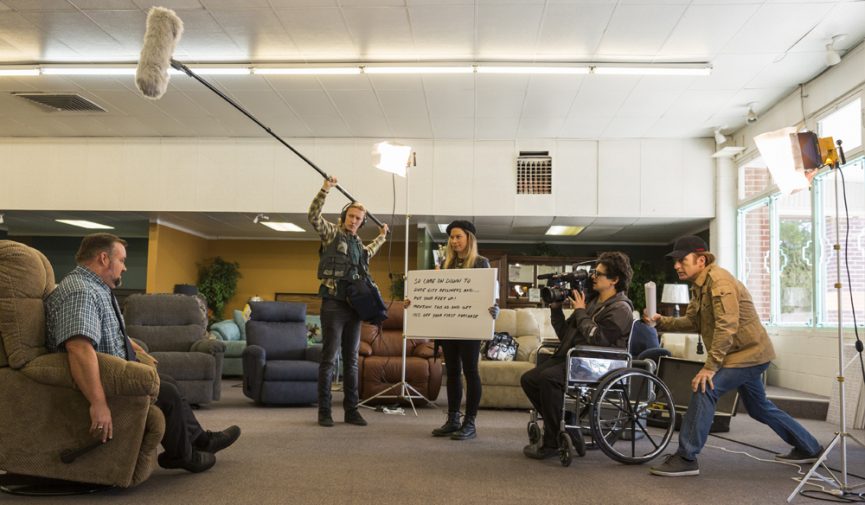By Michael Maher (https://www.premiumbeat.com/blog/filmmaking-tips-better-call-saul/)
Saul Goodman is a masterful commercial director. Learn from this frugal Breaking Bad and Better Call Saul filmmaker.
All images via AMC.
AMC’s Better Call Saul is best known for its portrayal of lawyers, but the most realistic characters in the show are the ragtag college kids shooting commercials for Jimmy McGill — a.k.a. Saul Goodman.

The techniques the crew in the show uses are true to life — most likely based on the real experiences of the show’s writers and crew. I know it certainly takes me back to my college days shooting any project I could, paid or unpaid — usually unpaid. I recall one of my biggest paydays was enough to cover my share of one month’s rent.
Let’s take a look at a few filmmaking tips you can learn from Saul Goodman and crew.
The Art of Guerrilla Filmmaking

The one thing you need to know about Saul Goodman (Bob Odenkirk) is that he is always willing to bend the rules. Goodman and his video crew are classic guerrilla filmmakers, operating with minimal equipment and never with any type of permit or permission.
Guerrilla filmmaking is all about getting the shot and getting out before anyone questions you. It’s a run-and-gun style of shooting that doesn’t cost anything. That being said, it certainly doesn’t mean you can shoot anywhere, anytime. If you are caught somewhere you shouldn’t be, you are subject to the laws of that area. You can easily face fines for trespassing, but it’s often a risk guerrilla filmmakers are willing to take.
- Go Undercover With These 5 Guerrilla Filmmaking Tactics
- Shooting Guerilla Style (At Your Own Risk): The 8 Tips You Need to Know — IndieWire
- How to Steer Clear of the Pitfalls of Guerrilla Filmmaking — No Film School
- Guerrilla Filmmaking is Inherently Risky — Huffington Post
- Run And Gun / Guerilla Filmmaking Tips — FilmRiot
Location Is Everything

A great location (and perfect timing) can really make your project. Like Saul Goodman shooting an old war plane with the sun setting in the background, you too can find the perfect location for your project. It requires plenty of location scouting and planning.
Here are some tips on location scouting — and some free templates for location release forms. If you can get permission to shoot on a location, it can actually give you and your crew time to set up and get the perfect shot.
- 3 Guerrilla Filmmaking Locations That Increase Production Value Every Time
- 5 Tips For Getting Great Film/Video Locations For Free
- Location Scouting Tips: The Whys and Hows of Where
- Scoring Great Film Locations On A Budget
- 5 Tips for Finding a Great Film Location
- Free Location Release Form for Film and Video Productions
Wheelchair Dolly

The wheelchair dolly is a tried-and-true camera stabilizer. It’s the perfect frugal rig. Wheelchairs offer smooth rides over nearly any surface, armrests to help hold the camera, and handles for pushing. They’re tough to beat. You can check online for used wheelchairs in your area, and you’re bound to find a cheap one. I found several for $40 – $60.
Need some more frugal tips on camera movement? Check out these helpful articles.
- 5 Simple Cinematography Hacks for Under $50
- Pocket Stabilizers for Videographers
- Create a Handheld Camera Rig for Less than $5
- Traditional Camera Moves Made Easy With DJI Drones
- DSLR Slider Guide For Solo Shooters
- Stabilizer Rigs for Run and Gun Gigs
Get a Sound Person — or at Least a Microphone

The biggest mistake every first-time filmmaker makes is focusing too much on video and not considering audio. Bad audio can ruin any video. If you aren’t an expert sound guy, you can try to find a friend who is. If not, you can always learn the basics in articles like the following.
- The Indie Filmmaker’s Guide to Recording Audio
- How to Set Audio Levels for Video
- Get Great Location Audio When Working as a One Man Band
- 9 Helpful Audio Tricks for Recording Documentary Interviews
- 17 Ways to Hide a Lavalier Mic
- Audio Tips for DSLR Filmmakers
- How to Capture High Quality Audio for Low Budget Films
- Hack Your H1 Audio Recorder for $15
- 10 Audio Accessories Under $100
- Piece Together a Pro Boom Mic for Around $500
- The Best Audio Recorders for Under $300
- Turning Old iPhones Into Wireless Mics
Cut with Exciting Transitions and Video Assets

You don’t have to use star wipes, but you can add some production value to your projects with cool transitions. You can certainly purchase awesome transition packs, but the real frugal filmmaker is here for free stuff. Here are some links to free assets and tutorials on creating your own transitions.
- Video Editor Toolbox: Over 1,000 Free Video Assets, Plug-ins, LUTs, SFX, and More!
- 10 Free Packs: Over 125 Must-Have Assets for Video Editors
- How to Fake a VHS Look in After Effects
- 13 Free 4K Light Leaks
- 7 Free Filmmaking Books and Guides
Paydays are Hard to Come By — Pay Your Crew Anything

When you are starting out in this industry, it can really suck. I can’t emphasize that enough. So much of advancing your career comes from your work ethic and dedication to the craft.
No matter how frugal you are, pay your crew something — even if it isn’t very much. They are much more likely to come back and work for someone who pays anything vs. someone who always asks them to work for free.
Keep your budget in order by putting together the right kind of crew, and don’t hire unnecessary crew members.

No comments:
Post a Comment